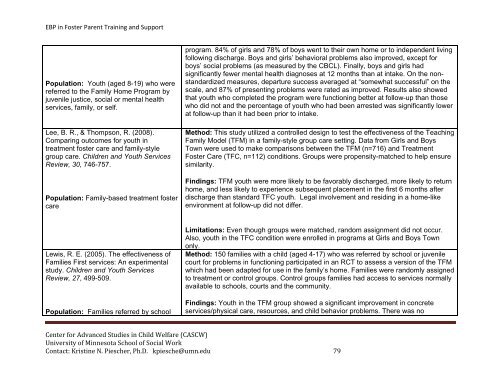Evidence-Based Practice in Foster Parent Training and Support ...
Evidence-Based Practice in Foster Parent Training and Support ...
Evidence-Based Practice in Foster Parent Training and Support ...
Create successful ePaper yourself
Turn your PDF publications into a flip-book with our unique Google optimized e-Paper software.
EBP <strong>in</strong> <strong>Foster</strong> <strong>Parent</strong> Tra<strong>in</strong><strong>in</strong>g <strong>and</strong> <strong>Support</strong>Population: Youth (aged 8-19) who werereferred to the Family Home Program byjuvenile justice, social or mental healthservices, family, or self.Lee, B. R., & Thompson, R. (2008).Compar<strong>in</strong>g outcomes for youth <strong>in</strong>treatment foster care <strong>and</strong> family-stylegroup care. Children <strong>and</strong> Youth ServicesReview, 30, 746-757.Population: Family-based treatment fostercareprogram. 84% of girls <strong>and</strong> 78% of boys went to their own home or to <strong>in</strong>dependent liv<strong>in</strong>gfollow<strong>in</strong>g discharge. Boys <strong>and</strong> girls’ behavioral problems also improved, except forboys’ social problems (as measured by the CBCL). F<strong>in</strong>ally, boys <strong>and</strong> girls hadsignificantly fewer mental health diagnoses at 12 months than at <strong>in</strong>take. On the nonst<strong>and</strong>ardizedmeasures, departure success averaged at “somewhat successful” on thescale, <strong>and</strong> 87% of present<strong>in</strong>g problems were rated as improved. Results also showedthat youth who completed the program were function<strong>in</strong>g better at follow-up than thosewho did not <strong>and</strong> the percentage of youth who had been arrested was significantly lowerat follow-up than it had been prior to <strong>in</strong>take.Method: This study utilized a controlled design to test the effectiveness of the Teach<strong>in</strong>gFamily Model (TFM) <strong>in</strong> a family-style group care sett<strong>in</strong>g. Data from Girls <strong>and</strong> BoysTown were used to make comparisons between the TFM (n=716) <strong>and</strong> Treatment<strong>Foster</strong> Care (TFC, n=112) conditions. Groups were propensity-matched to help ensuresimilarity.F<strong>in</strong>d<strong>in</strong>gs: TFM youth were more likely to be favorably discharged, more likely to returnhome, <strong>and</strong> less likely to experience subsequent placement <strong>in</strong> the first 6 months afterdischarge than st<strong>and</strong>ard TFC youth. Legal <strong>in</strong>volvement <strong>and</strong> resid<strong>in</strong>g <strong>in</strong> a home-likeenvironment at follow-up did not differ.Lewis, R. E. (2005). The effectiveness ofFamilies First services: An experimentalstudy. Children <strong>and</strong> Youth ServicesReview, 27, 499-509.Population: Families referred by schoolLimitations: Even though groups were matched, r<strong>and</strong>om assignment did not occur.Also, youth <strong>in</strong> the TFC condition were enrolled <strong>in</strong> programs at Girls <strong>and</strong> Boys Townonly.Method: 150 families with a child (aged 4-17) who was referred by school or juvenilecourt for problems <strong>in</strong> function<strong>in</strong>g participated <strong>in</strong> an RCT to assess a version of the TFMwhich had been adapted for use <strong>in</strong> the family’s home. Families were r<strong>and</strong>omly assignedto treatment or control groups. Control groups families had access to services normallyavailable to schools, courts <strong>and</strong> the community.F<strong>in</strong>d<strong>in</strong>gs: Youth <strong>in</strong> the TFM group showed a significant improvement <strong>in</strong> concreteservices/physical care, resources, <strong>and</strong> child behavior problems. There was noCenter for Advanced Studies <strong>in</strong> Child Welfare (CASCW)University of M<strong>in</strong>nesota School of Social WorkContact: Krist<strong>in</strong>e N. Piescher, Ph.D. kpiesche@umn.edu 79
















